1994 BUICK PARK AVENUE service schedule
[x] Cancel search: service schedulePage 11 of 324
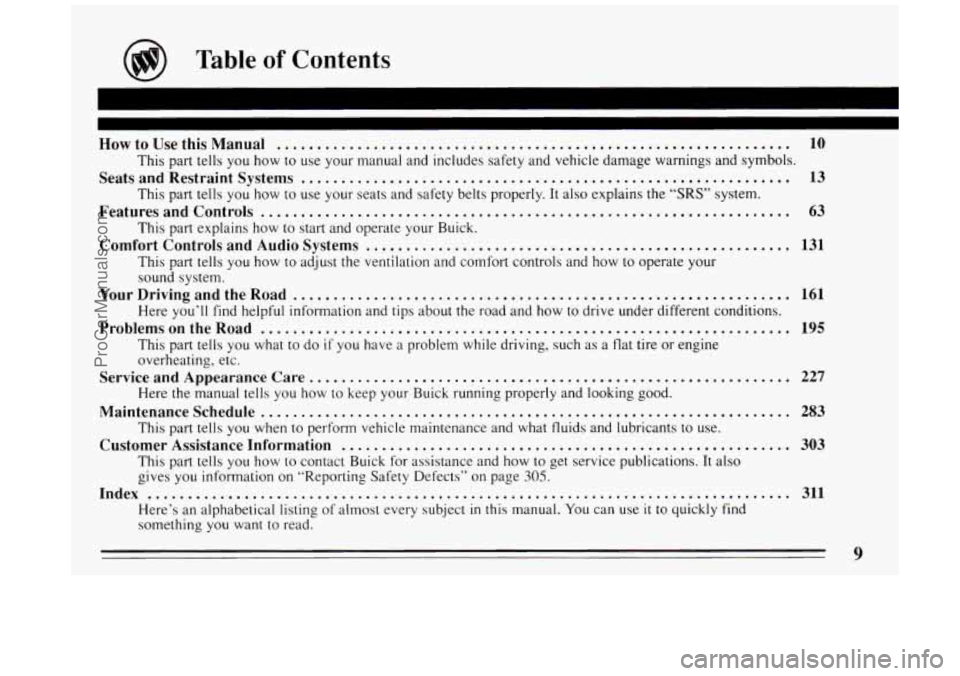
Table of Contents
How to Use this Manual ................................................................ 10
This part tells you how to use your manual and includes safety and vehicle damage \
warnings and symbols.
Seats and Restraint Systems ............................................................. 13
This part tells you how to use your seats and safety belts properl\
y. It also explains the “SRS” system.
FeaturesandControls .................................................................. 63
This part explains how to start and operate your Buick.
Comfort Controls and Audio Systems ..................................................... 131
This part tells you how to adjust the ventilation and comfort controls and how to operate your
sound system.
Here you’ll find helpful information and tips about
the road and how to drive under different conditions.
ProblemsontheRoad .................................................................. 195
This part tells you what to do if you have a problem while driving, such as a flat tire or engine
overheating, etc.
Here
the manual tells you how to keep your Buick running properly and \
looking good.
This part tells you when to perform vehicle maintenance and what fluids and lubricants to use.
This part tells you how
to contact Buick for assistance and how to get service publications. It also
gives you information on “Reporting Safety Defects” on pag\
e
305.
Here’s an alphabetical listing of almost every subject in this manual. You can use it to quickly find
something you want to read.
YourDrivingandtheRoad .............................................................. 161
Serviceand Appearancecare
............................................................ 227
Maintenanceschedule .................................................................. 283
Customer Assistance Information
........................................................ 303
Index
........................................................................\
........ 311
9
ProCarManuals.com
Page 196 of 324
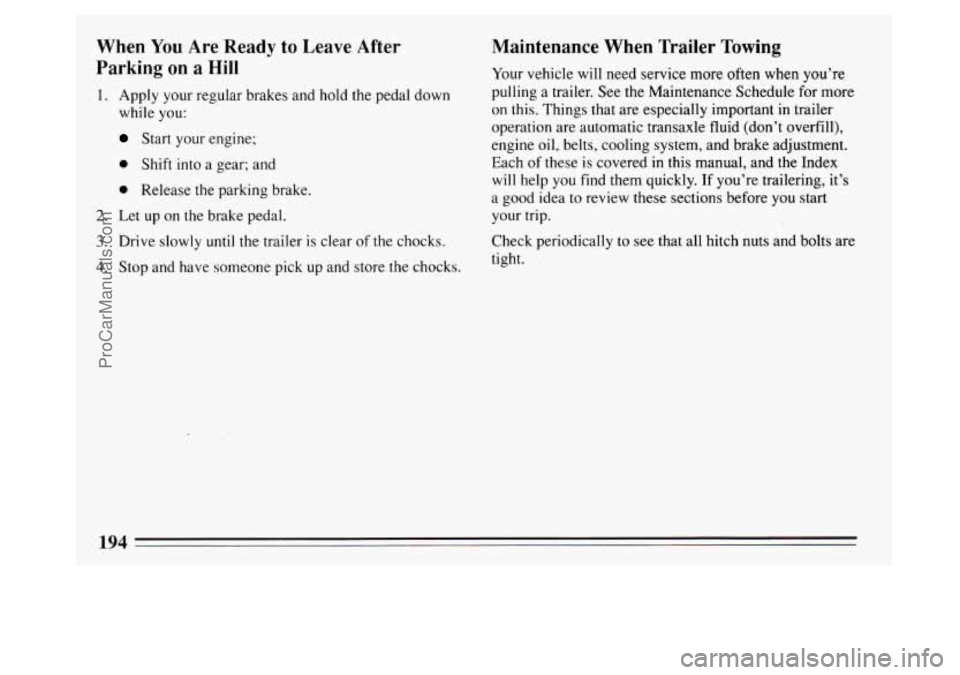
When You Are Ready to Leave After
Parking on a Hill
1. Apply your regular brakes and hold the pedal down
while you:
Start your engine;
0 Shift into a gear; and
0 Release the parking brake.
2. Let up on the brake pedal.
3. Drive slowly until the trailer is clear of the chocks.
4. Stop and have someone pick up and store the chocks.
Maintenance When Trailer Towing
Your vehicle will need service more often when you’re
pulling a trailer. See the Maintenance Schedule for more
on this. Things that are especially important in trailer
operation are automatic transaxle fluid (don’t overfill),
engine oil, belts, cooling system, and brake adjustment.
Each of these is covered in this manual, and the Index
will help you find them quickly. If you’re trailering, it’s
a good idea to review these sections before you start
your trip.
Check periodically to see that all hitch nuts and bolts are
tight.
194
ProCarManuals.com
Page 246 of 324
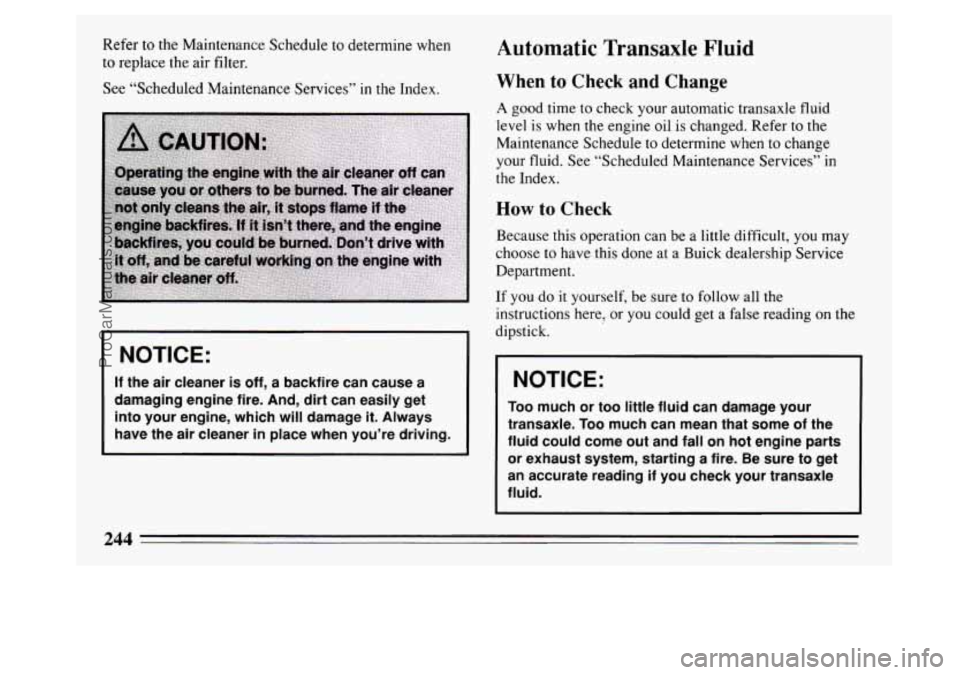
Refer to the Maintenance Schedule to determine when
to replace the air filter.
See “Scheduled Maintenance Services”
in the Index.
NOTICE:
If the air cleaner is off, a backfire can cause a
damaging engine fire. And, dirt can easily get
into your engine, which will damage
it. Always
have the air cleaner
in place when you’re driving.
Automatic Transaxle Fluid
When to- Check and Change
A good time to check your automatic transaxle fluid
level is when the engine oil is changed. Refer
to the
Maintenance Schedule to determine when to change
your fluid. See “Scheduled Maintenance Services’’ in
the Index.
How to Check
Because this operation can be a little difficult, you may
choose
to have this done at a Buick dealership Service
Department.
If you do it yourself, be sure to follow all the
instructions here, or you could get a false reading
on the
dipstick.
NOTICE:
Too much or too little fluid can damage your
transaxle.
Too much can mean that some of the
fluid could come out and fall on hot engine parts
or exhaust system, starting a fire. Be sure
to get
an accurate reading if you check your transaxle
fluid.
244
ProCarManuals.com
Page 264 of 324
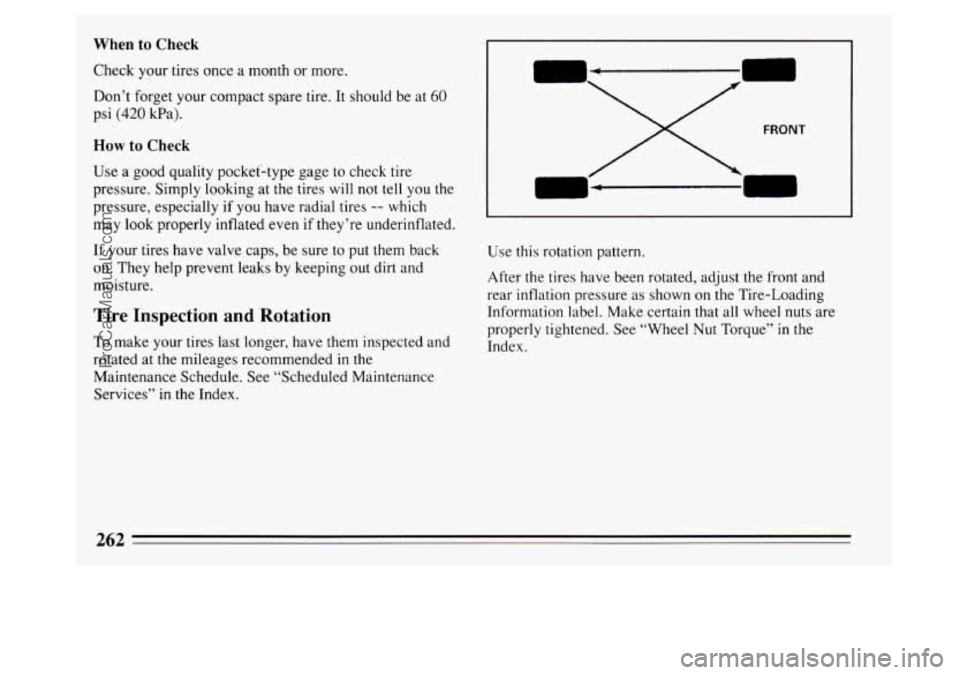
When to Check
Check your tires once a month or more.
Don’t forget your compact spare tire. It should be at
60
psi (420 Wa).
How to Check
Use a good quality pocket-type gage to check tire
pressure. Simply looking at the tires will not tell you the
pressure, especially
if you have radial tires -- which
may look properly inflated even if they’re underinflated.
If your tires have valve caps, be sure to put them back
on. They help prevent leaks by keeping out dirt and
moisture.
Tire Inspection and Rotation
To make your tires last longer, have them inspected and
rotated at the mileages recommended
in the
Maintenance Schedule. See “Scheduled Maintenance
Services”
in the Index.
FRONT
Use this rotation pattern.
After the tires have been rotated, adjust the front and
rear inflation pressure
as shown on the Tire-Loading
Information label. Make certain that all wheel nuts are
properly tightened. See “Wheel Nut Torque” in the
Index.
262
ProCarManuals.com
Page 285 of 324
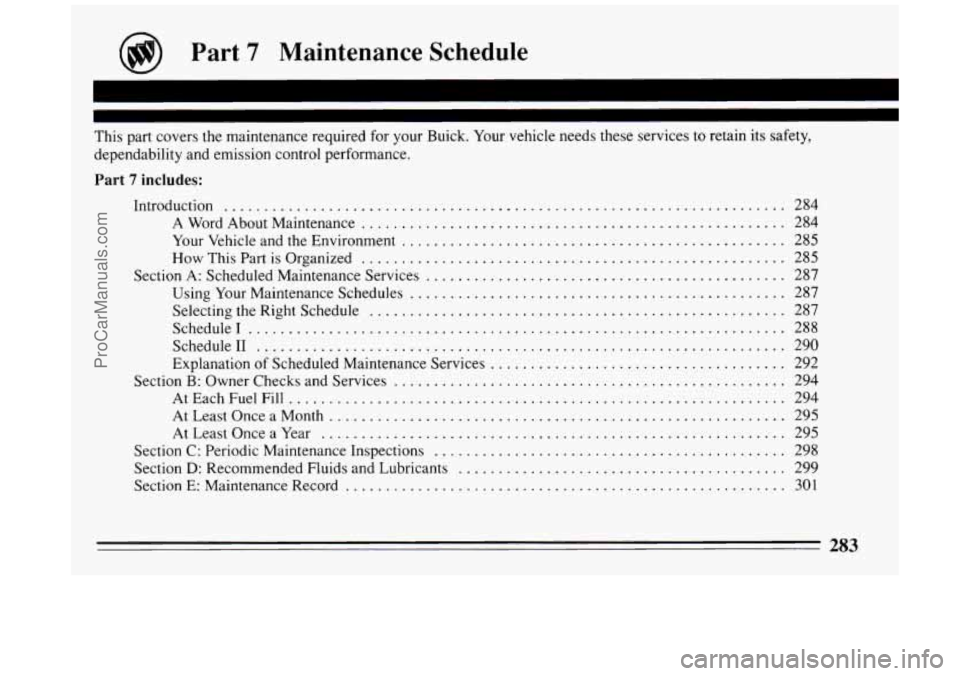
@) Part 7 Maintenance Schedule
This part covers the maintenance required for your Buick . Your vehicle needs these services to retain its safety.
dependability and emission control performance
.
Part 7 includes:
Introduction ......................................................................
A Word About Maintenance .....................................................
Your Vehicle and the Environment ................................................
How This Part is Organized .....................................................
Section A: Scheduled Maintenance Services .............................................
Using Your Maintenance Schedules ...............................................
Selecting the Right Schedule ....................................................
Schedule1 ...................................................................
Schedule11 ..................................................................
Explanation of Scheduled Maintenance Services .....................................
Section B: Owner Checks and Services .................................................
AtEachFuelFill ..............................................................
AtLeastOnceaMonth .........................................................
AtLeastOnceaYear ..........................................................
Section C: Periodic Maintenance Inspections ............................................
Section D: Recommended Fluids and Lubricants .........................................
Section E: Maintenance Record .......................................................
284
284
285
285
287 287
287
288
290
292
294
294
295 295
298
299
301
283
ProCarManuals.com
Page 287 of 324
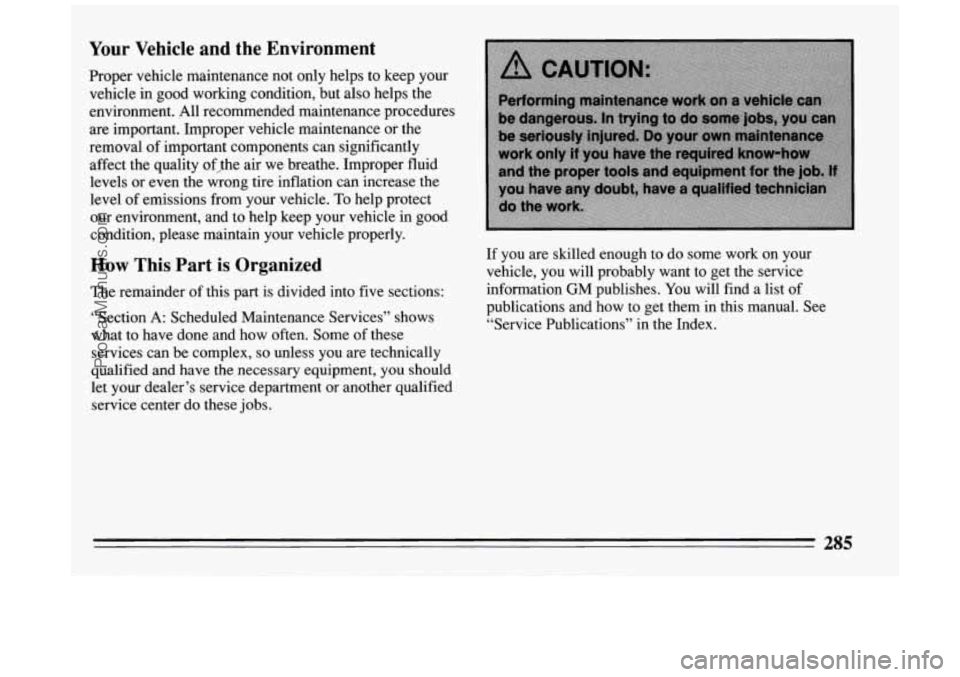
Your Vehicle and the Environment
Proper vehicle maintenance not only helps to keep your
vehicle in good working condition, but also helps the
environment. All recommended maintenance procedures
are important. Improper vehicle maintenance
or the
removal of important components can significantly
affect the quality of_the air we breathe. Improper fluid
levels or even the wrong tire inflation can increase the
level of emissions from your vehicle.
To help protect
our environment, and to help keep your vehicle in good
condition, please maintain your vehicle properly.
How This Part is Organized
The remainder of this part is divided into five sections:
“Section A: Scheduled Maintenance Services” shows
what
to have done and how often. Some of these
services can be complex,
so unless you are technically
qualified and have the necessary equipment, you should
let your dealer’s service department or another qualified
service center do these
jobs.
If you are skilled enough to do some work on your
vehicle, you will probably want to get the service
information GM publishes. You will find a list of
publications and how to get them in this manual. See
“Service Publications” in the Index.
ProCarManuals.com
Page 289 of 324
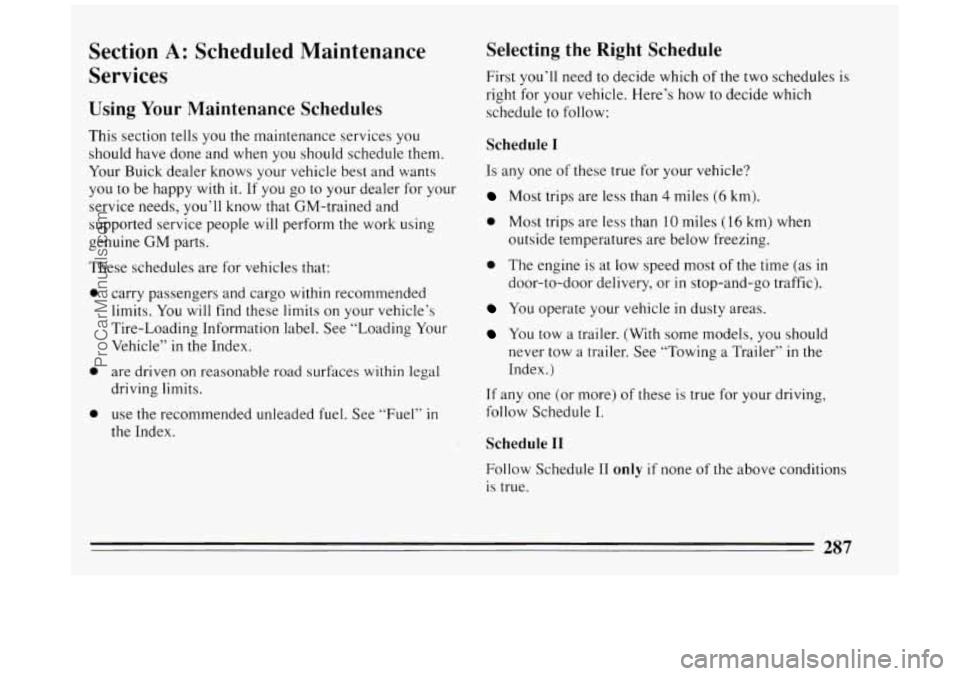
Section A: Scheduled Maintenance
Services
Using Your Maintenance Schedules
This section tells you the maintenance services you
should have done and when you should schedule them.
Your Buick dealer knows your vehicle best and wants
you
to be happy with it. If you go to your dealer for your
service needs, you’ll know that GM-trained and
supported service people
will perform the work using
genuine GM parts.
These schedules are for vehicles that:
0
0
0
carry passengers and cargo within recommended
limits.
You will find these limits on your vehicle’s
Tire-Loading Information label. See “Loading Your
Vehicle”
in the Index.
are driven on reasonable road surfaces
within legal
driving limits.
use the recommended unleaded fuel. See “Fuel”
in
the Index.
Selecting the Right Schedule
First you’ll need to decide which of the two schedules is
right for your vehicle. Here’s how to decide which
schedule to follow:
Schedule I
Is any one of these true for your vehicle?
Most trips are less than 4 miles (6 km).
0 Most trips are less than 10 miles ( 16 km) when
outside temperatures are below freezing.
door-to-door delivery, or
in stop-and-go traffic).
0 The engine is at low speed most of the time (as in
You operate your vehicle in dusty areas.
You tow a trailer. (With some models, you should
never tow a trailer. See “Towing
a Trailer” in the
Index.)
If any one (or more) of these is true for your driving,
follow Schedule
I.
Schedule I1
Follow Schedule I1 only if none of the above conditions
is true.
287
ProCarManuals.com
Page 290 of 324
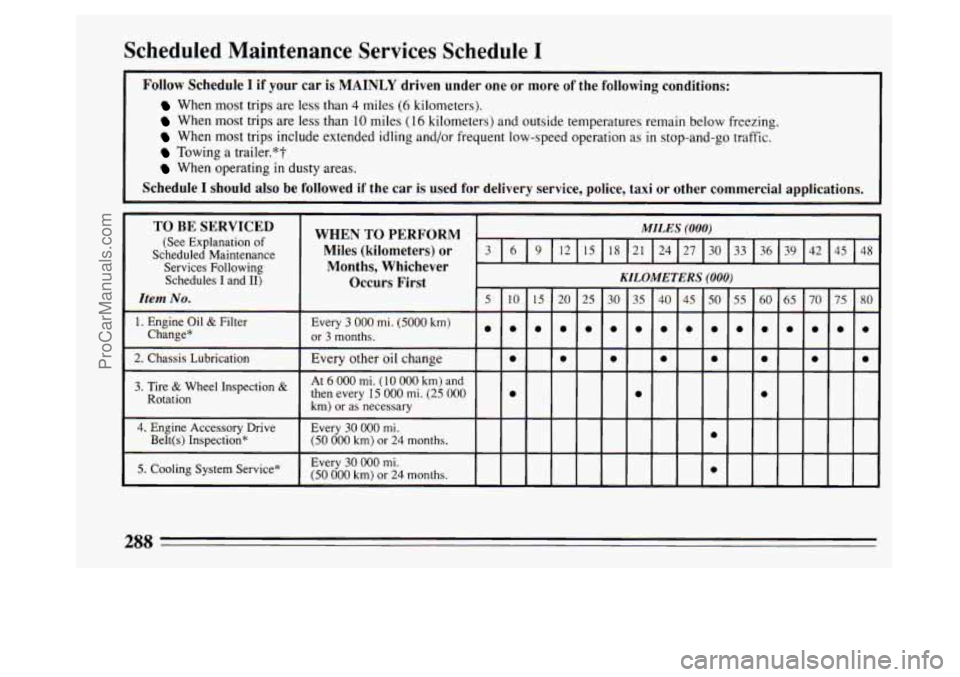
Scheduled Maintenance Services Schedule I - - ~~~~
Follow Schedule I if your car is MAINLY driven under one or more of the following conditions:
When most trips are less than 4 miles (6 kilometers).
When most trips are less than 10 miles (16 kilometers) and outside temperatures remain below freezing.
When most trips include extended idling and/or frequent low-speed operation as in stop-and-go traffic.
Towing a trailer.*?
When operating in dusty areas.
Schedule I should also be followed if the car is used for delivery service, police, taxi or other commercial applications.
288
ProCarManuals.com